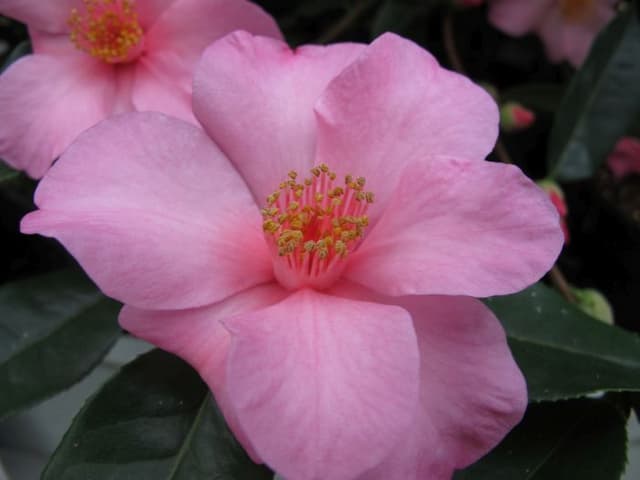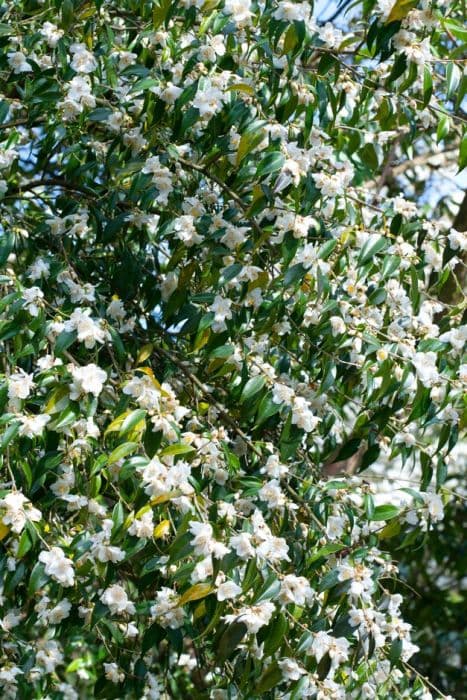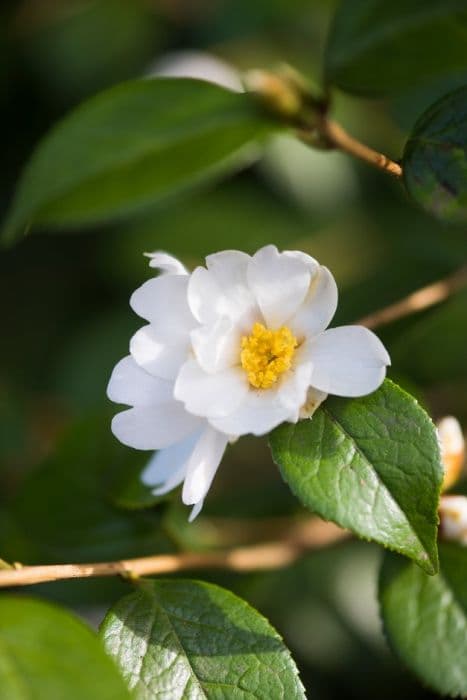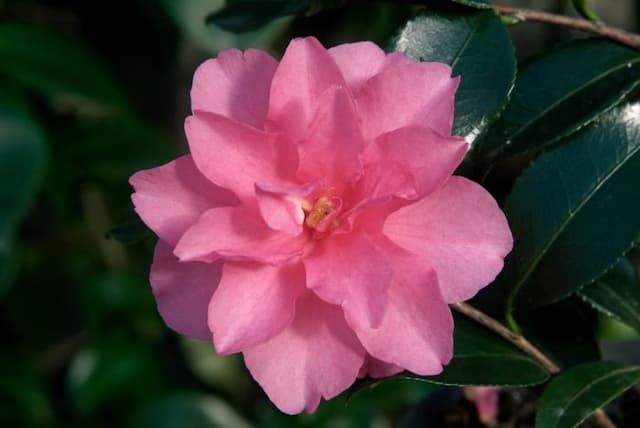Camellia 'Candy Apple' Camellia japonica 'Candy Apple'

ABOUT
'Candy Apple' is a large, evergreen shrub with dense, bushy , upright growth and glossy, dark green leaves. Semi-double, red flowers, 8-10cm across, are produced in late winter and early spring
About this plant
 Names
NamesFamily
Theaceae.
Synonyms
Japanese Camellia, Camellia, Common Camellia.
Common names
Camellia japonica 'Candy Apple'.
 Characteristics
CharacteristicsLife cycle
Perennials
Foliage type
Evergreen
Color of leaves
Green
Flower color
Pink
Height
6-12 feet (1.8-3.7 meters)
Spread
6-10 feet (1.8-3 meters)
Plant type
Shrub
Hardiness zones
7
Native area
Japan
Benefits
 General Benefits
General Benefits- Ornamental Value: Camellia japonica 'Candy Apple', commonly known as Japanese Camellia, offers stunning red blossoms that enhance garden aesthetics.
- Long Blooming Season: This variety has a long flowering period that spans from late winter through spring, offering color when few other plants are in bloom.
- Evergreen Foliage: Japanese Camellia has glossy evergreen leaves that provide year-round interest and greenery in the landscape.
- Drought Tolerance: Once established, it has moderate drought tolerance, making it suitable for gardens with occasional water restrictions.
- Shade Tolerance: It can thrive in partial shade, allowing it to be planted beneath taller trees or in areas with limited direct sunlight.
- Privacy Screen: With its dense growth habit, it can be used as a living privacy screen or to hide unsightly views.
- Wildlife Attraction: The flowers of the Japanese Camellia can attract pollinators such as bees and sometimes hummingbirds, supporting local ecosystems.
- Versatility: This plant is versatile and can be used in a variety of landscape designs, including formal gardens, woodland settings, and as specimen plants.
- Low Maintenance: Japanese Camellia generally requires low maintenance once established, with minimal pruning and care needed.
- Cultural Significance: Camellias have been culturally significant in many Asian cultures, particularly in Japan and China, and can bring a sense of tradition and history to a garden.
 Medical Properties
Medical PropertiesThis plant is not used for medical purposes.
 Air-purifying Qualities
Air-purifying QualitiesThis plant is not specifically known for air purifying qualities.
 Other Uses
Other Uses- As an artistic muse: The Camellia japonica is often depicted in paintings, photography, and sculptures due to its vibrant color and symmetrical form.
- In clothing dye: The petals can be used to create natural dyes for fabric, giving a soft pink to red hue depending on the concentration.
- In floral arrangements: Camellia japonica is a popular choice for corsages, boutonnieres, and as an elegant component in floral displays due to its durability and aesthetic.
- As a bonsai plant: Enthusiasts cultivate Camellia japonica bonsai for its ability to adapt to pruning and create miniature landscapes.
- For crafting: The petals can be pressed and used in crafting, such as in homemade paper or to adorn handmade candles and cards.
- As symbolism: In certain cultures, Camellia japonica represents love and affection, making it an emblematic gift between loved ones.
- In horticultural competitions: Growers of Camellia japonica often enter their plants in shows and competitions judged on flower form, color, and plant vigor.
- As a theme in literature and film: The beauty and transient nature of Camellia japonica blooms is used symbolically in storytelling.
- For photography practice: Their distinctive blooms are favorite subjects for photographers honing their macro and close-up photography skills.
- In wedding decor: The blooms and foliage of Camellia japonica can be integrated into wedding bouquets, centerpieces, and venue decorations for their beauty and symbolism.
Interesting Facts
 Feng Shui
Feng ShuiThe Camellia is not used in Feng Shui practice.
 Zodiac Sign Compitability
Zodiac Sign CompitabilityThe Camellia is not used in astrology practice.
 Plant Symbolism
Plant Symbolism- Admiration: Camellias generally symbolize admiration and are often given as a token of high regard and respect.
- Perfection: The perfect form and nature of the camellia's petals represent the ideal, striving for perfection in every aspect of life.
- Love and Affection: The Camellia, particularly in a warm color like 'Candy Apple', is often associated with deep desire, passion, and romantic love.
- Longevity: Being an evergreen with a long blooming season, camellias can symbolize the enduring and steadfast nature of life, hinting at longevity and immortality.
- Devotion: The resilience of the camellia through cold seasons reflects the steadfast nature of devotion, symbolizing faithful love and commitment.
 Water
WaterFor Camellia japonica, commonly known as Japanese Camellia, the soil should be kept moist but never waterlogged. It is best to water deeply when the top inch of soil feels dry to the touch, which typically means watering once a week. Depending on the size of your plant and the weather conditions, you might find yourself watering with approximately 1-2 gallons of water each time. It’s important not to let the plant dry out completely, but be cautious of over-watering as it can lead to root rot. During the winter months, reduce watering frequency as the plant’s growth slows down.
 Light
LightJapanese Camellia thrives in partial shade to dappled sunlight. It is best situated in a spot that gets morning light and is shielded from the intense afternoon sun. These light conditions emulate the plant's natural habitat under forest canopies. Ensure enough diffused light reaches the camellia to encourage healthy growth without exposing it to strong, direct sunlight, which can scorch the leaves.
 Temperature
TemperatureJapanese Camellia prefers temperate environments and is best kept in temperatures ranging from 70°F to 85°F. While it can withstand temperatures briefly dipping down to around 20°F, frost can damage the buds and flowers. Camellias generally prefer cooler nighttime temperatures, ideally around 50°F to 60°F. Avoid sudden temperature shifts and protect the plant from extreme cold or heat.
 Pruning
PruningPruning of Japanese Camellia should be done to shape the plant, remove dead or weak wood, and encourage airflow, which can prevent disease. The best time to prune is just after the blooms have faded in the spring, but before the new bud set begins. Prune every year or every other year, depending on the plant's growth and your desired shape.
 Cleaning
CleaningAs needed
 Soil
SoilCamellia japonica, also known as Japanese Camellia, thrives best in acidic soil with a pH range of 5.5 to 6.5. The ideal soil mix is well-draining and rich in organic matter; a blend of 2 parts peat moss, 1 part perlite, and 1 part pine bark would be optimal for 'Candy Apple' to grow robustly.
 Repotting
RepottingJapanese camellias like 'Candy Apple' usually need repotting every 2-3 years to ensure they have enough space to grow and adequate nutrients. The best time to repot is in late winter or early spring, before the growing season begins.
 Humidity & Misting
Humidity & Misting'Candy Apple' variety Japanese camellia prefers high humidity levels, ideally between 50% to 60%. If indoor air is too dry, consider using a humidifier or placing a water tray near the plant to enhance the humidity.
 Suitable locations
Suitable locationsIndoor
Place Japanese Camellia in bright, indirect light indoors.
Outdoor
Plant in part-shade, shelter from strong winds outdoors.
Hardiness zone
7-9 USDA
 Life cycle
Life cycleThe common camellia (Camellia japonica 'Candy Apple') begins its life cycle as a seed, which germinates in a warm and moist environment to produce a small seedling. This seedling grows into a juvenile plant with increasing leaf number and size, establishing a root system. As it matures, the camellia develops woody stems and a robust foliage canopy, entering its vegetative stage. Upon reaching sexual maturity, the plant produces buds that bloom into large, ornate, rose-like red flowers typically in late winter to spring. After pollination, these flowers develop into brown, globe-shaped seed capsules containing the seeds for the next generation. The camellia's life cycle is perennial, allowing it to bloom annually for many years with proper care and favorable conditions.
 Propogation
PropogationPropogation time
Spring-Summer
For Camellia japonica 'Candy Apple', commonly known as the Japanese Camellia, the most popular method of propagation is by semi-hardwood cuttings. This is typically undertaken in late summer to early autumn when the plant's growth has started to harden but is not yet fully woody. To propagate, a cutting of about 4 to 6 inches (10 to 15 centimeters) is taken, making sure that it includes at least two to three sets of leaves. The lower leaves are removed, and the cut end may be dipped in rooting hormone to encourage root development. The cutting is then placed in a well-draining potting mix, and the environment is kept humid with consistent but not overly wet soil. Covering the cutting with a plastic bag or using a mist system can help maintain humidity. Roots typically develop in several weeks to a few months, after which the new plant can be transplanted.









